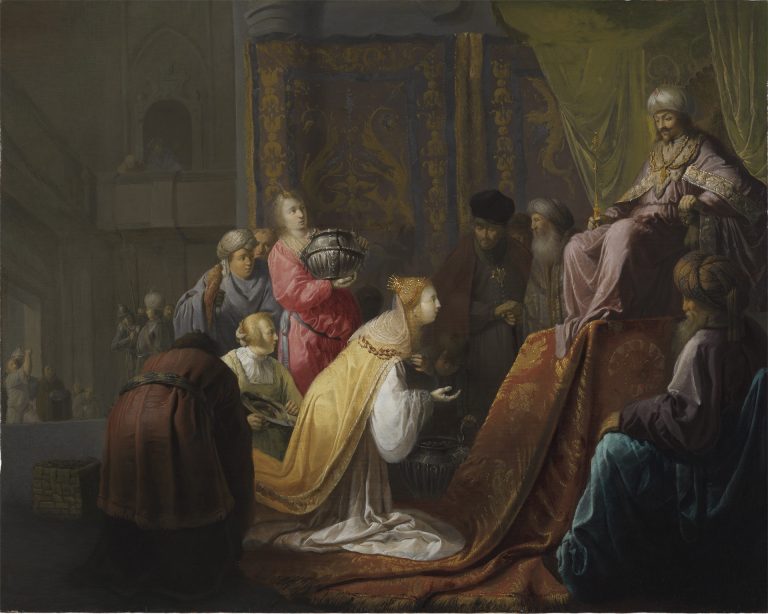In this vibrantly colored little painting, Willem de Poorter depicts the Old Testament story of the Queen of Sheba’s visit to King Solomon, recounted in 1 Kings 10:1–13. The queen, increasingly skeptical about the legendary wisdom and monotheistic religion of King Solomon, traveled with a large caravan from Sheba (probably modern Yemen) to the king’s court in Jerusalem to test him with challenging questions. After Solomon had answered each of her queries successfully, and after she had witnessed his peaceful, civilized court, she was moved with admiration for the king and his God. She then lavished Solomon with gold, spices, and precious stones.
De Poorter depicts the moment just after the Queen of Sheba’s disbelief has turned into conviction. Accompanied by servants who hold the vessels with expensive gifts, she kneels before the king, her royal status evident in her golden crown and the elegant yellow mantle draped over her white dress. With her back slightly bent and her right palm open, she respectfully looks up to the king, who, clad in purple robes and a white turban, towers above the queen on a high, canopied throne with a brocaded tapestry cascading down from its platform. An infrared image indicates that De Poorter had originally planned for the queen’s head to be more raised and directed at the king’s face, but he lowered her gaze during the painting process to emphasize her humility (fig 1).
De Poorter contrasted the bright, primary colors of the robes worn by the queen and her entourage with the subdued purples, greens and grays worn by Solomon and his court, in order to emphasize the different cultural traditions represented in this scene. Indeed, De Poorter depicted the visitors gazing at the king with awe and the locals watching their guests with curiosity. This sense of curiosity is repeated in the background, where the court’s guards watch members of the queen’s caravan carrying vessels into the spacious interior.
Werner Sumowski first published this unsigned and undated work as a painting by Willem de Poorter in 1983.1 Sumowski convincingly related the panel to two early paintings by De Poorter of roughly the same dimensions: the artist’s earliest dated painting, Tarquinius Finding Lucretia at Work, 1633 (fig 2), and his Sacrifice of Jephta’s Daughter (fig 3).2 In all three works, De Poorter created similar figure groupings and positioned them close to the picture plane.3 Each composition is also closed at the right by a large repoussoir figure. Moreover, the facial features of the queen’s servant dressed in red are identical to those of the figure standing behind the high priest in Sacrifice of Jephta’s Daughter. Stylistic similarities are even found between the underdrawing of Solomon and the Queen of Sheba (fig 4) and De Poorter’s drawn copy of Rembrandt’s 1630 Jeremiah Lamenting the Destruction of Jerusalem in the Rijksmuseum (fig 5).4 In each instance, De Poorter drew contours with unbroken, firm lines and modeled his forms with straight, parallel lines and free-flowing, zigzagged hatchings.
A striking difference between these works is that Solomon and the Queen of Sheba has no strong contrasts of light and dark. From the mid-1630s onwards, De Poorter increasingly used dramatic lighting in his history paintings.5 Thus, it is probable that he executed Solomon and the Queen of Sheba in the early 1630s, before he started to develop his interest in chiaroscuro effects.6 At this early stage of his career, De Poorter looked carefully at a number of his predecessors for inspiration. For the general composition of this scene, De Poorter seems to have referred to the engraving Solomon and the Queen of Sheba, 1549, based on a design by his fellow townsman Maarten van Heemskerck (1498–1574). In that print the queen is similarly situated in the center of the scene, with her followers to the left and the king and his court to the right.7 Known also to De Poorter would have been the works of the most important history painter of his day, Pieter Lastman (1583–1633). A similar ornate curtain behind the main scene and a division between the colorful foreground and gray-hued background appear in Lastman’s 1619 David Gives Uriah a Letter for Joab in the Leiden Collection.8 Finally, the unusually high throne suggests that De Poorter knew the history paintings of the Delft master Leonaert Bramer (1596–1674).9
In medieval typology, the story of Solomon visited by the Queen of Sheba was regarded as a prefiguration of the Adoration of the Magi. The magi also came from afar and carried exotic gifts to acknowledge the Lord.10 This typology seemingly inspired Leonaert Bramer to pair his painting Solomon and the Queen of Sheba with Adoration of the Magi.11 It is possible that De Poorter’s painting was originally conceived as part of such a typological pair, or belonged to a larger series of the life of Solomon.12
